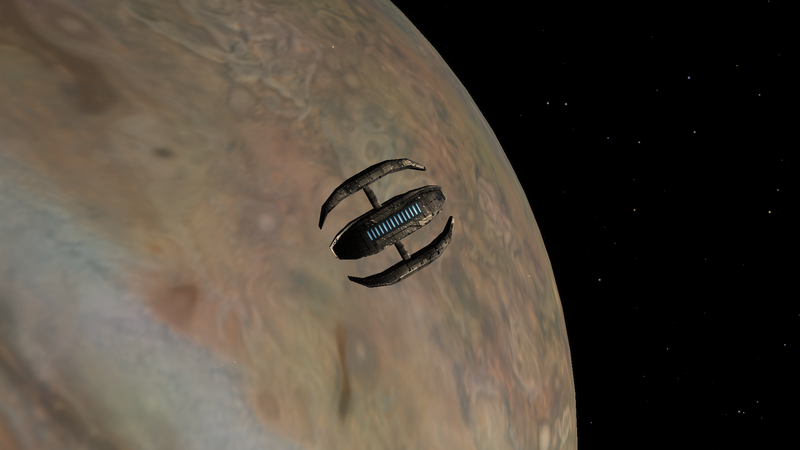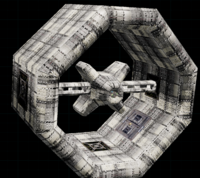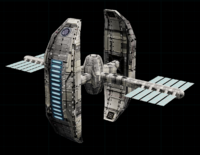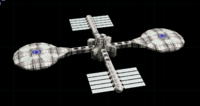OrbitalStations
This OXP (part of Strangers World) puts into operation a network of stations, moving on circular orbits around various bodies in the system. All the stations in this planned network have specific roles and corresponding markets.
Lock your Advanced Space Compass onto a K beacon and enjoy a flight to a new destination!
If you have been enjoying regular Oolite, and wish a change, you might prefer not to read the descriptions in Features which follows - and discover them in-game! But Stranger's Overview essay gives an insight into some difficulties of programming for Oolite.
Contents
Preamble
Ideas with a revolutionary potential sometimes remain underestimated or just unnoticed!
This is the case for the Satellites OXP (author – Rorschachhamster). Seemingly just a nice exercise in coding and just one more OXP in the Ambience category.
But, it is a jolly hard task to simulate true orbital dynamics in Oolite:
In the real world, the calculation of orbital dynamics is based on the integration of acceleration vectors and on the energy conservation law. If you have no acceleration produced by a propulsion engine, your total energy (sum of kinetic and potential energy) would have a constant value. So on an elliptic orbit you’ll trade velocity for altitude and vice versa.
In Oolite we have no gravity nor energy. Acceleration is limited to propulsion acceleration/deceleration parameter thrust and this is not a vector value – it is just the rate of change of ship speed. So we need some trick to simulate true orbital dynamics – calculating the ship's position for the next frame and placing the ship directly into it.
Unfortunately JavaScript is not a suitable instrument for smooth dynamic simulations! It generates only 4 fps, so you’ll see the jerky sequence of frames instead of a decent illusion of smooth movement.
Bad idea. Forget it.
Satellites OXP uses a more elegant approach, based on AI behavior. It generates a realistically looking pattern of circular movement around a planet without sophisticated mathematics.
... Let’s try to apply this approach to a large ship. Large enough to be dockable.
You've got the idea.
Overview
Orbital Stations OXP puts into operation a network of stations, moving on circular orbits.
All stations in the network have specific roles and markets.
Kiota class stations from WildShips OXP (author Thargoid) were used as prototypes for my orbiters. Kiota stations have a modular design, suitable for assembling custom configurations. These stations have reach-through axial docking well, allowing easy closing and docking from a six o’clock chasing position. And these stations have a pretty looking appearance. Nice job, Thargoid!
It is technically possible to adjust each orbiter velocity individually to simulate orbital periods as a function of planet mass and orbit radius, but I have no plans to implement such an idea. The escape velocity in our Solar system is 2.38 km/s for Moon and 59.5 km/s for Jupiter – a 25x ratio. All orbiters have H = 0.5 R circular orbits, so orbital velocities will be in the same 25x ratio. Setting the orbital velocity of a jovian orbiter to 200 m/s to allow an Adder or Boa to dock with station will have 8 m/s for the lunar orbiter – a barely noticeably movement. So I decided to sacrifice accuracy for fun. All orbiters have the same visible orbital velocity of 50 m/s.
Features
KHS Orbital Stations implemented:
- KHS-2R
- KHS-4R
- KHS-8R
These are Main stations in high technology systems. They have the same configuration as the original ring-habitat stations in the Wild Ships OXP, but with different seeding criteria. These are stationary (not moving) stations, so you can save your game at them.
KOS Orbital Stations implemented (planetary, solar, lunar):
- KOS-RJ Jovian research orbiter
- KOS-RM Martian research orbiter
- KOS-RT Terran research orbiter
- KOS-RS Superterran research orbiter
These planetary research orbital stations occur in high-tech systems with stable governments and a high GNP. All research orbiters except the Jovian orbiter have the same configuration.
- KOS-M A mining complex in a heliocentric orbit. Located in high-tech systems with stable governments and high GNP.
- KOS-P An orbital plant orbiting a large moon of the main planet. Located in most advanced high-tech systems with stable governments and high GNP.
General comments
- All stationary KHS stations have the role of main system station (with F3F3 shipyards etc) as well as the usual default F8 system market.
- KOS orbiters have customised markets, adjusted individually for each type of station.
Retextures for WildShips Stations
Retextures for WildShips Stations also works on these orbital stations, freshening the diffuse, normal and specular maps for all the WildShips Kiota stations, making use of the new features in Oolite 1.90/1.91. Downloadable through the in-game Expansions Manager or via the wiki here
Dependencies and conflicts
Required OXP: Planetary Systems This OXP uses planets from Planetary Systems OXP as destination points for station spawn. If you have Planetary Systems missing, Orbital Station OXP still try to spawn stations but results may be negative or logically flawed (for example, you should have no research stations orbiting gas giants if you don't have at least one gas giant in the system!).
The stations used are modified Kiota stations from WildShips OXP (author - Thargoid). Orbital Stations and Wild Ships use different station roles and seeding scripts, so in theory Orbital Stations should not conflict with Wild Ships. The only possible issue will be shared resource files: if Wild Ships will be released with updated resource files, old files from Orbital Stations can conflict new ones from Wild Ships. So to avoid possible clashes original resource files from Wild Ships were renamed and references were updated. Main orbital stations KHS completely replaces the old Torus stations. Remove the various Tori .oxps from the ManagedAddOns folder to see the new stations!
You may need the Navigation MFD to see the details of which station is which.
This package's minimum requirement is Oolite 1.82.
Credits
- Station models, shaders and textures are renamed files from Wild Ships OXP (author - Thargoid). Specifications of stations are readjusted.
- Algorithm of seeding stations based on Stations for Extra Planets OXP (author - Spara).
- Algorithm of orbital movement based on Satellites OXP (author - Rorschachhamster).
- Station market saver script tightly based on PlanetfallMarketSaver (author - SMax).
- Help of Commander Vasig in the heavy testing of this OXP was and will be invaluable!
License
This OXP is released under the Creative Commons Attribution - Non-Commercial - Share Alike 3.0 license. You are free to use and distribute this OXP on non-commercial basis. Rebundling of this OXP within another distribution is permitted as long as it is unchanged. Any mods/derivatives of this OXP must be distributed under another names. The license information (either as this file or merged into a larger one) must be included in the OXP.
Version history
- 17.06.2020 - Version 2.7.0 Code edited again to synchronise with updated Planetary Systems OXP.
- 15.02.2019 - Version 2.6.0 Renamed original resource files from Wild Ships and updated appropriate references.
Code refactoring to synchronise with changed file names.
- 10.02.2019 - Version 2.5.2 Edited manifest.plist
- 10.02.2019 - Version 2.5.1 Converted to OXZ.
- 01.01.2019 - Version 2.5 Station market saver script refined to support redefined station roles.
- 21.06.2018 - Version 2.4 Code edited to synchronise with updated Planetary Systems OXP.
KOS RT stations divided onto 3 subclasses to adopt advanced planet classification.
- 09.05.2018 - Version 2.3 Code edited to satisfy OXP Standards recommendations.
Code adopted to redefined Planetary Systems planet database.
- 25.10.2017 - Version 2.2 Code improvement - kill delay timer after stations seeding.
- 31.08.2016 - Version 2.1 Station market saver script added.
- 27.07.2016 - Version 2.0 Kiota ball turret weapon range reduced from 7500 to 7200 m to fix too high range error.
- 16.07.2016 - Version 1.9 Seeding code rewritten to adopt Planetary Systems and Moons extended set.
- 05.01.2016 - Version 1.8 A bit randomness in orbiters seeding condition added.
- 30.11.2015 - Version 1.7 All orbiters max flight speed decreased to 50 to allow emergency docking in case of fuel depletion.
- 25.09.2015 - Version 1.6 KOS-M and KOS-P market slightly readjusted.
- 04.07.2015 - Version 1.5 KOS-M orbital mine complex puts into operation.
Station seeding restricted to stable systems with high GNP.
- 22.06.2015 - Version 1.4 Rebalanced markets.
- 19.06.2015 - Version 1.3 Station markets rewritten completely for Oolite 1.82.
More strict rules for jovian and martian orbiter: no more these stations in low tech systems.
- 17.12.2014 - Version 1.2 Fixed Oolite 1.80 specific problem with seeding of martian KOS-RT station (planet radius instead texture is used now to find Mars)
- 30.11.2014 - Version 1.1 Price to upgrades in orbital plant (KOS-P station) increased from 0.8 to 0.9 of main equipment price.
- 21.05.2014 - Version 1.0 Scripts optimised to use global function library.
Fixed bug in selecting target planet algorithm.
- 18.05.2014 - Version 0.9 Seeding of martian station KOS-RT improved to adopt changes in Planetary Systems planet texture names.
- 30.04.2014 - Version 0.8 Seeding of KOS-P station refined to avoid interference with Moons.oxp.
- 12.03.2014 - Version 0.7 Fixed bug in scripts - test for interstellar space refined.
- 10.03.2014 - Version 0.6 Main geostationary stations KHS-2R/4R/8R puts into operation.
- 04.03.2014 - Version 0.5 KOS-P orbital factory puts into operation.
New shaders from Wild Ships OXP integrated.
- 18.02.2014 - Version 0.4 Fixed bug in shipdata.plist (missing AI.plist link for martian station).
Defence mode in AI implemented (still need refining yet!).
- 15.02.2014 - Version 0.3 Seeding algorithm refined. Stations seeds with 5 s delay after launch from main station or entering new system.
Compatibility with Wild Ships OXP improved.
- 08.02.2014 - Version 0.2 Structure of OXP rewritten to adopt multiple stations support.
KOS-RT research station puts into operation. shipdata.plist refined to fix escaping Kiota main stations.
- 07.02.2014 - Version 0.1 Initial release.
KOS-RJ research station puts into operation.
Links
- Bulletin Board Discussion
- Strangers World




